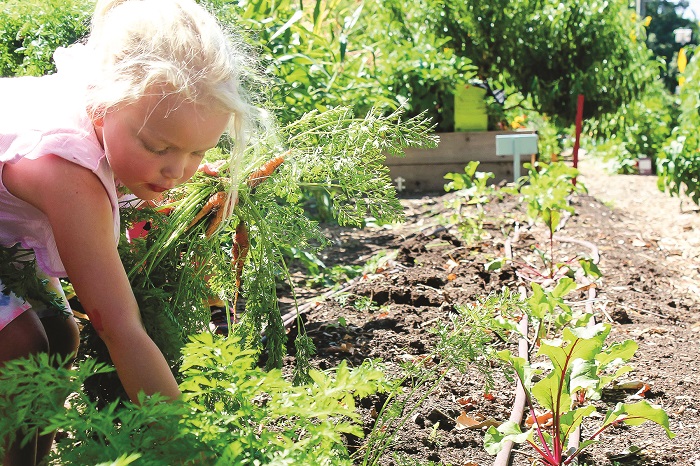
“Let it be known, I am a fairly lazy gardener,” says Geneva Lawrence, long-time Sugar House horticulturist, of her extensive backyard filled with five raised beds, grape and berry vines, fruit trees, beehives and a gaggle of happy hens. “One reason I use cover crops is because it’s an easy way to feed the dirt. Sow, water, leave alone.”
This relatively hands-off approach yields great results for Lawrence, who through most of the year is able to feed her family of four (and several of her very lucky friends and neighbors) from her residential lot’s bounty. Of her five garden beds, she rotates one out of production every year, to which she plants a cover crop of organic soil builder peas and oats (Pisum sativum/avena sativa).
Says Lawrence, “I sow them in early spring, let them grow, and then roughly chop them into the soil in the fall, leaving the roots in the ground.” Weather permitting, she grows an autumn crop of leafy greens in the same bed as the cover crops, so she doesn’t lose production space for the whole growing year.
Although it takes patience and lots of organic matter to improve notoriously hardscrabble Utah soil, Dancing Moose Montessori School’s master gardener, Nichole Mathews, says that it pays off. “Our soil is so bad that it will probably take a couple of more years” to get it to the ideal fertility levels she’d like to see at their West Valley City campus. “I have done buckwheat and peas in the beds the last couple of years,” she says, and within just a few seasons of cover cropping and intensive composting, they now have a school garden overflowing with grape vines, berry bushes, a giant teepee covered in bean vines, 50 row boxes for planting, and a variety of thriving fruit trees.
A Sugar House gardener of twenty years, Susan Anderson says that even when home gardens are too small to pull a bed out of production for a season, a combination of cover crops and planting bed rotations can dramatically improve soil. She recommends the websites for both Wasatch Community Gardens and the Utah State University agricultural extension regarding the benefits of using cover crops for soil nutrient improvement, superior water retention, natural (instead of chemical spray) weed control, and for attracting beneficial insects.
 Case in point: The first thing Anderson does to prepare her garden beds early each March is to broadcast cover crops of crimson clover and buckwheat by top-scattering handfuls of both seeds. “They jump-start your garden,” says Anderson of these cover crops. “Everywhere I plan to plant veggies gets a good scatter of seeds.” As she starts to move transplants and direct-sow vegetables in her garden, she just spades under the cover crops into the garden bed, which immediately works as green mulch.
Case in point: The first thing Anderson does to prepare her garden beds early each March is to broadcast cover crops of crimson clover and buckwheat by top-scattering handfuls of both seeds. “They jump-start your garden,” says Anderson of these cover crops. “Everywhere I plan to plant veggies gets a good scatter of seeds.” As she starts to move transplants and direct-sow vegetables in her garden, she just spades under the cover crops into the garden bed, which immediately works as green mulch.
Anderson likes to keep some of the crimson clover growing between row crops as a natural way to prevent weeds and attract pollinating insects. “It’s great stuff,” she says,“It’s really pretty to see in the garden and the bees go nuts for it even really early in the spring.”
“Until I started gardening in Utah, I didn’t even know about cover crops,” says Anderson, a Wisconsin native. But in the twenty years she’s been gardening here, she’s come to be a cover crop convert. According to Anderson, it’s not that big of an investment in time or expense. “I’m out a few bucks, tops. If they get covered in snow or don’t take, it’s not that big of a deal to wait a few weeks and try again.” §
LEARN MORE:
Utah State University, electronic publishing pamphlet, “Cover Crops for Utah Gardens,”
Wasatch Community Gardens, “Why Use Cover Crops?”


